Beyond the Pandals: My Soul-Stirring Durga Puja Journey from Clay to Immersion
Hello, my fellow globetrotters and culture seekers!
If you think you’ve experienced festivals, think again. What we simply call ‘Pujo’ is not just a festival, mind you, for us, it’s an emotion. It’s the ‘Bangalir Paraash Parbon’ (The Bengalis’ greatest festival). It’s the five days a year when our city doesn’t just celebrate; it becomes the celebration.
As a son of this city and raised in the bylanes of South Kolkata, I’ve lived and breathed Pujo for over a decade. I’ve seen it evolve, yet its soul remains untouched. This isn’t just another travel guide. This is an invitation to see Pujo through my eyes—a local’s journey from the sacred clay of the potter’s lane to the bittersweet goodbye in the holy Ganga.
Buckle up, and aashchhi… (I’m coming).
#DurgaPuja #KolkataLocal #PujoInKolkata #Kolkatadiaries #BonediKolkata #CulturalImmersion #TravelIndia #IncredibleIndia #FestivalOfIndia #PandalHopping #SpiritualJourney
PROLOGUE: Mahalaya – The Dawn of the Divine
Weeks before the pandals rise, Pujo arrives on a whisper. It comes at 4 AM on Mahalaya, with the timeless, crackling voice of Birendra Krishna Bhadra from millions of radios. “Chondo podo…” he begins, and a shiver runs down every Bengali’s spine.
We wake in the pre-dawn darkness, not to alarm clocks, but to the chanting of the Mahishasura Mardini—the epic story of the Goddess slaying the buffalo demon. This, for us, is the official start. It’s the moment we believe the Goddess begins her celestial journey from her husband Shiva’s abode in Mount Kailash to her maternal home on Earth—our Kolkata.
This isn’t a spectacle you watch; it’s a feeling you inherit. It’s in the air. The faint chill of the retreating monsoon, the smell of new books in the pujo barshiki (annual magazines), and the restless energy that says, “Pujo aashche!” (Pujo is coming!).
PART 1: Protibaader Ohonkar – The Roar of Creation in Kumartuli
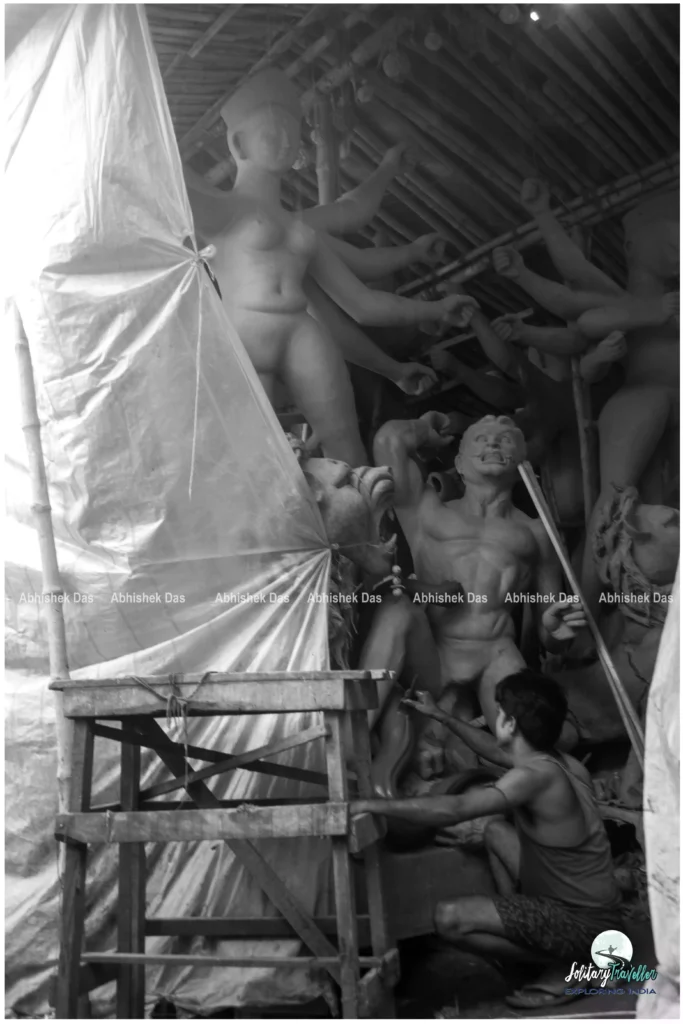
Before the glitter, there is the clay. Before the music, there is the silence of creation. My first pilgrimage is always to Kumartuli.
#Kumartuli #BehindTheScenes #ArtisanStories #ClayToDivine #KolkataHeritage #LocalSecrets
Ekti Koler Kaaj: It’s a Handmade Affair
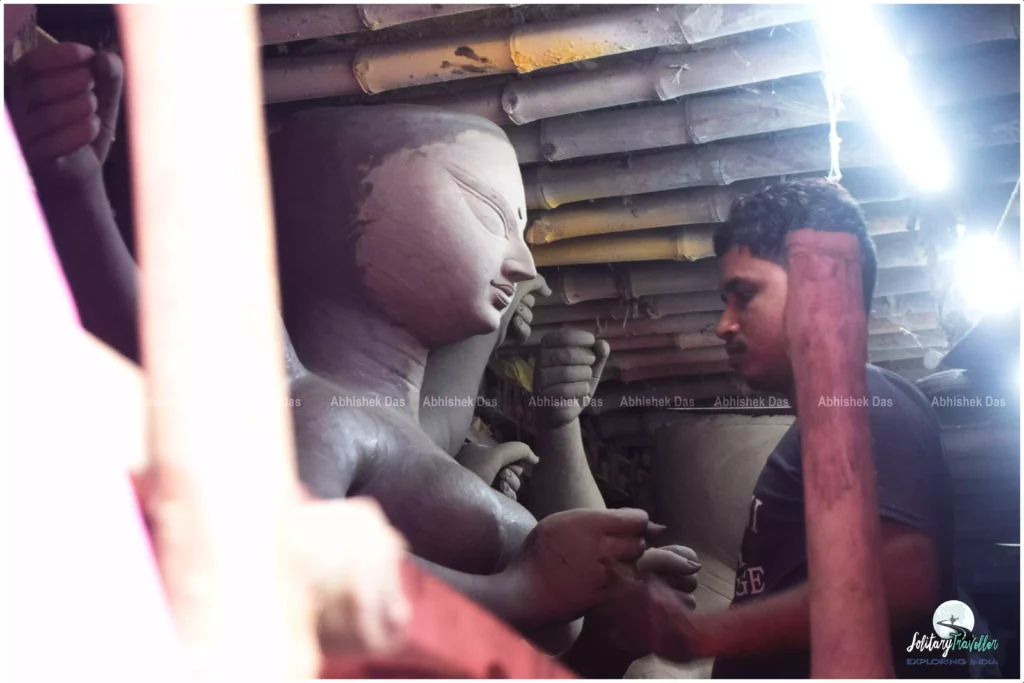
Forget the serene artist studios you imagine. Kumartuli is a beautiful, chaotic, sweat-soaked, and sacred factory of faith. The narrow lanes are so cramped you have to walk sideways. Bamboo spines of giant idols poke out of rooftops. The air is thick with the gondho of maati—the primal scent of the Ganga’s clay, mixed with the sweetness of straw and the sharpness of synthetic paint.
This is my Kolkata version of a holy site. I’ve talked to Gurupada Pal da who has been making idols for years. His grandfather taught his father. In his cramped, dimly lit studio, illuminated by a single, naked bulb, where magic unfolds.
Shristir Kram: The Alchemy of Idol Making
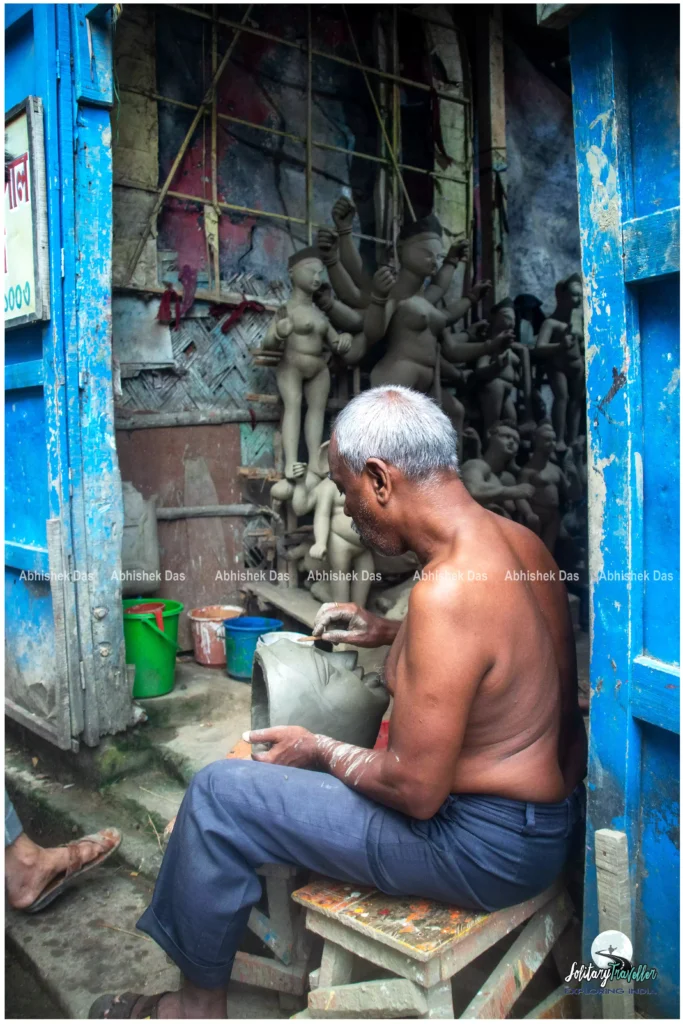
Watching Gurupada da work is like watching a centuries-old ritual. It’s a process we learn about in school, but seeing it live never loses its wonder.
- Kathamo: The Bamboo Skeleton. It starts with a framework of bamboo and straw. This is the asthishar—the bones. It defines Maa Durga’s iconic, triumphant posture.
- Mati Diye Kaaj: The Muscle and Flesh. Layers of coarse clay, mixed with jute, are slapped onto the skeleton. The form begins to emerge—the powerful lion, the struggling Mahishasur, the serene, powerful Mother.
- Ganga Mati: The Soul Infusion. This is the most profound step. The final layer is made from Ganga Mati—sacred clay collected from the banks of the Hooghly. This isn’t a technicality; it’s a sacrament. It connects the idol to its final destination from the very beginning. We believe the Ganga’s purity resides within the idol because of this.
- Chokkhudaan: The Bestowal of Sight. The most senior artisan paints the eyes on Mahalaya or on a designated day. This ritual, the Chokkhudaan, is when the inanimate clay is believed to become a vessel for the divine. The studio falls silent. It’s a moment of collective reverence.
- Daaker Saaj: The Adornment. The final step is the decoration. The term Daaker Saaj dates back to when ornaments were ordered from Kolkata by mail (daak). Now, it refers to the dazzling jewellery made of shola pith, tinsel, and cloth that transforms the clay form into our radiant Mother.
Local’s Insight: Don’t just go to Kumartuli to take pictures. Go to feel. Talk to the artists. Ask them about their sleepless nights. Buy a small, handcrafted doll. That ₹100 note means more to them than you can imagine. This is where our Pujo truly begins, in the hands of these unsung heroes.
PART 2: Shohorer Rang – When Kolkata Becomes the Greatest Show on Earth
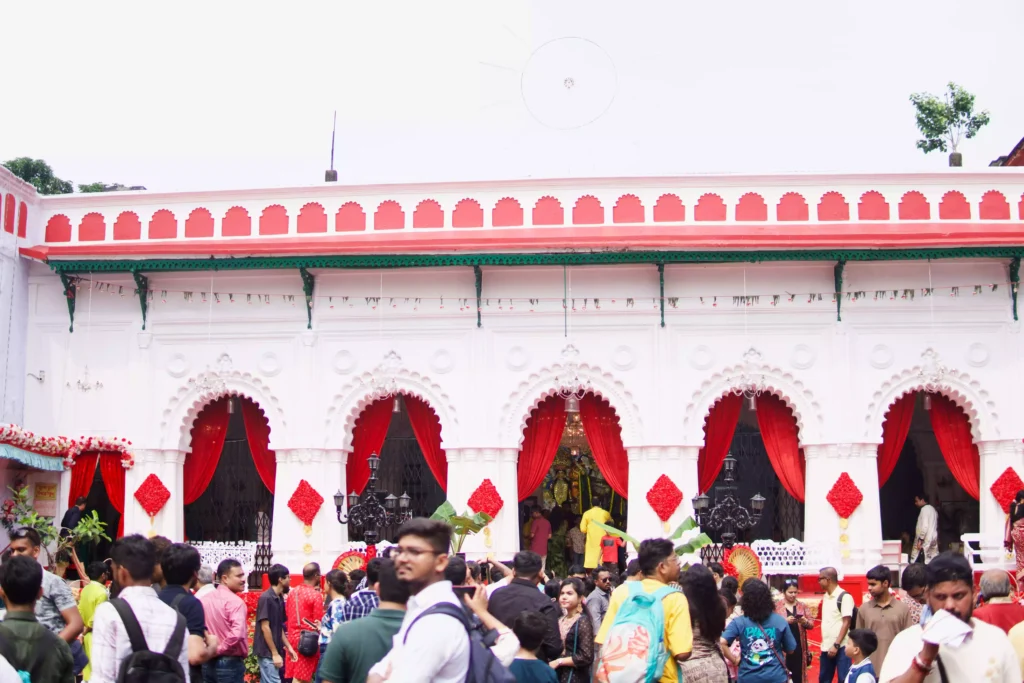
And then, it happens. The city holds its breath on Shashthi, the sixth day, and then explodes into a five-day-long dream on Saptami.
#PandalHopping #KolkataPujo #ArtInstallation #PhygitalPujo #KolkataFood #DhunuchiNaach #PujoVibes
Pandal Hopping: The Great Kolkata Art Crawl
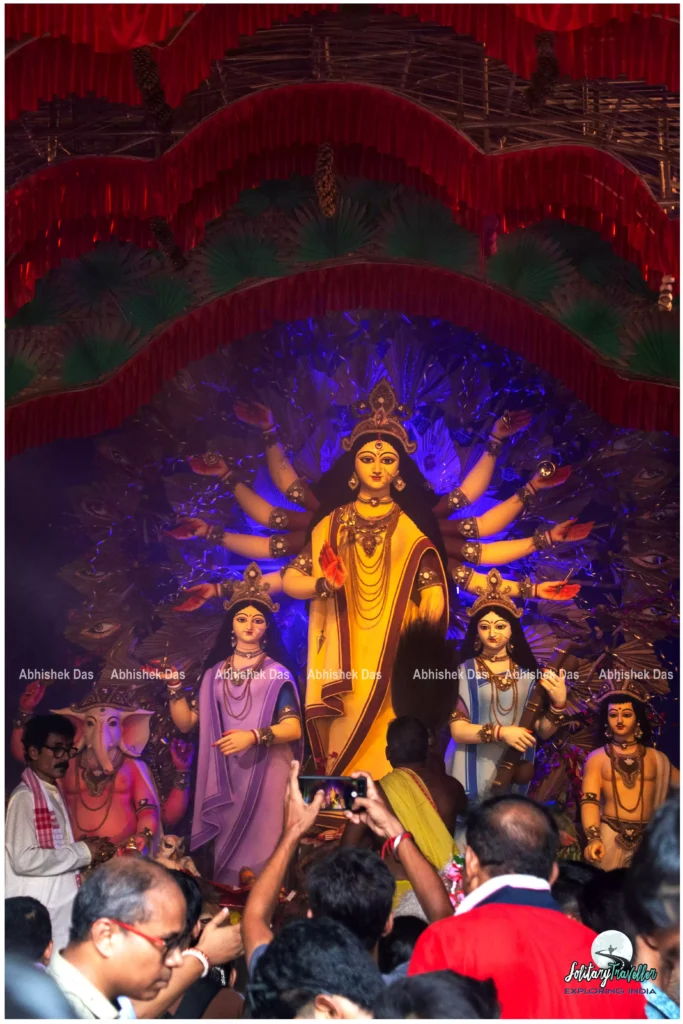
For the next 96 hours, Kolkata is a free, open-air, 24/7 art gallery. We don’t ‘visit’ pandals; we ‘hop’ between them. It’s a marathon, not a sprint.
- The Themes: A Mirror to Our World: Each year, the themes astound me. One pandal might be a perfect replica of the Konark Sun Temple, another a stunning commentary on global warming made from plastic bottles, and yet another an avant-garde metallic labyrinth. It’s our city’s pulse, its anxieties, and its hopes, rendered in bamboo, cloth, and light.
- North vs. South: The Friendly Rivalry: As a South Kolkatan, I’m biased.
- North Kolkata (My ‘Para’): Here, like Shobhabazar, Bagbazar, and Kumartuli, Pujo is about ‘poribesh’ (ambience) and tradition. The pandals may be less flashy, but the sense of community is thicker than the crowd. It’s about the old Bonedi (aristocratic) families and their timeless rituals.
- South Kolkata: Areas like Santoshpur, Ekdalia, and Hindustan Park are the kings of ‘theme’ pujos. They are spectacular, cinematic, and draw millions. The art is cutting-edge, and the queues are legendary.
The Soundtrack: Dhaker Taal
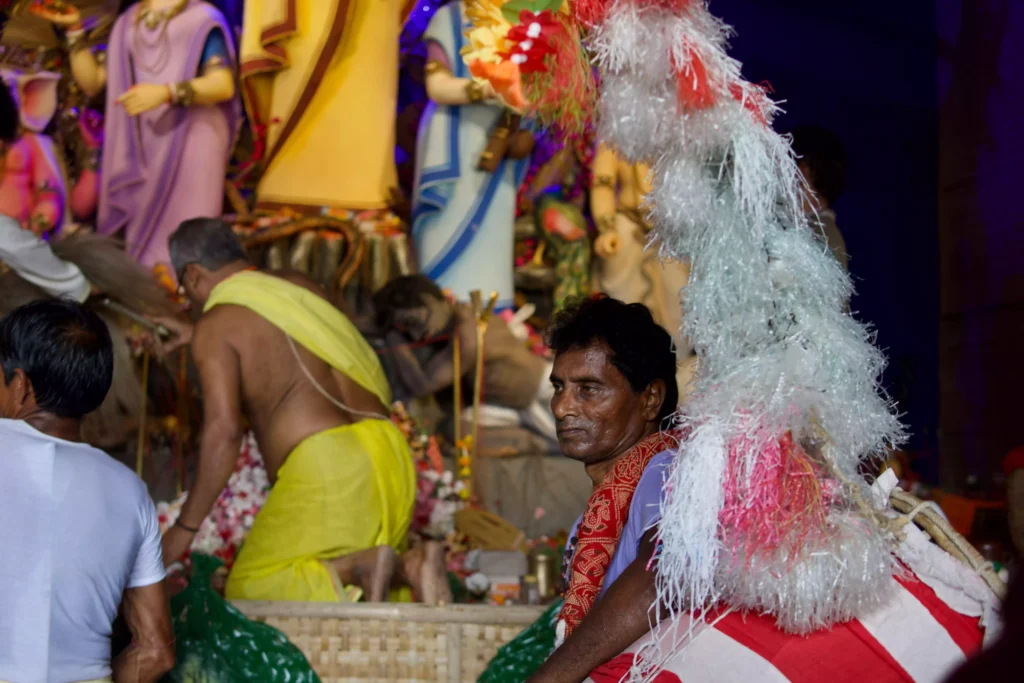
Amidst the visual riot, there is a constant, primal heartbeat—the ‘dhak’. The sound of this drum isn’t just music; it’s a vibration. It’s the sound of Pujo itself. ‘Dhinak dhinak dhinak…’ It starts slow and builds to a frenzied crescendo during the aarti. It’s impossible to stand still. Your feet tap, your heart syncs, and before you know it, you’re swaying.
The People: Anando Durgotsav
But the true magic of Pujo is the people. For five days, the city sheds its cynicism. We wear our best clothes—the crispest dhotis, the most beautiful handloom sarees. We walk the streets all night, not as strangers, but as fellow devotees in a collective dream. The universal greeting, ‘Shubho Bijoya!’, is exchanged with smiles that reach the eyes. The city doesn’t sleep, and neither do we.
PART 3: Bidaayer Shokha – The Bittersweet Farewell on the Ganga
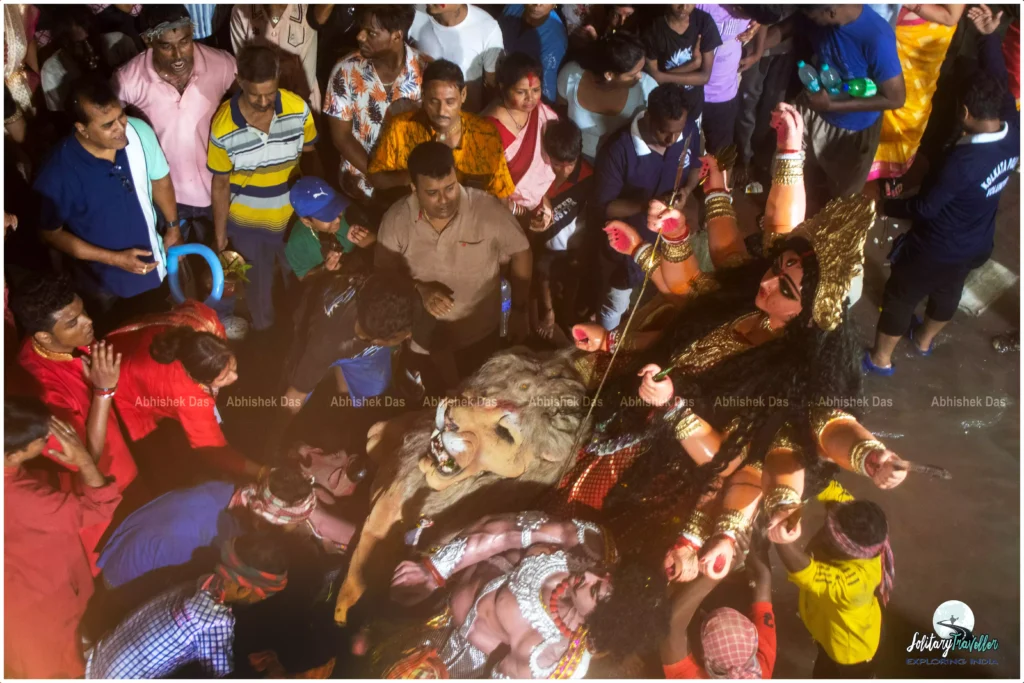
All good things must end. On Dashami, the tenth day, the euphoria curdles into a sweet, piercing melancholy. The day of ‘Bisarjan’ (immersion) has arrived.
#Bisarjan #GangaImmersion #Dashami #EmotionalGoodbye #SpiritualKolkata #RiverGanga
Sindoor Khela: The Women’s Festival
Before the procession begins, there is a ritual exclusive to the women—Sindoor Khela. Married women smear vermillion on the Goddess and then on each other. They offer sweets, pray for the long lives of their husbands, and celebrate their power, their ‘shakti’. It’s a vibrant, powerful, and deeply moving spectacle of sisterhood. As a man, I can only watch from a distance, but the energy is palpable.
The Procession: A Carnival of Tears
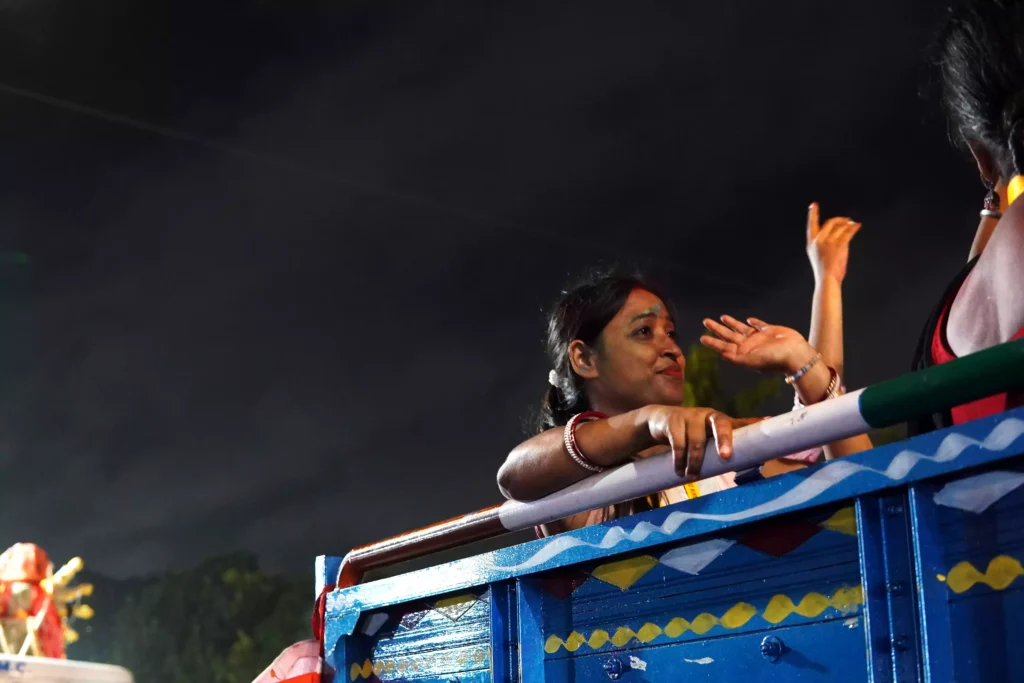
Then, the procession begins. The young men of our para hoist the heavy, beloved idol onto their shoulders. The dhak starts again, but the rhythm is different—faster, more frantic, almost desperate.
They dance with a wild, possessive energy, a final, explosive offering of their love for the Mother. The crowd follows, chanting, dancing, and crying. The air is thick with the smell of sweat, flowers, and the ‘sindoor’ being thrown into the air like crimson rain.
The chant that defines this moment, that embodies our Bengali spirit of hope, rings out: “Aashche Bochor Aabar Hobe!” (It will happen again next year!)
The Immersion: A Lesson in ‘Oshohojogita’ (Impermanence)
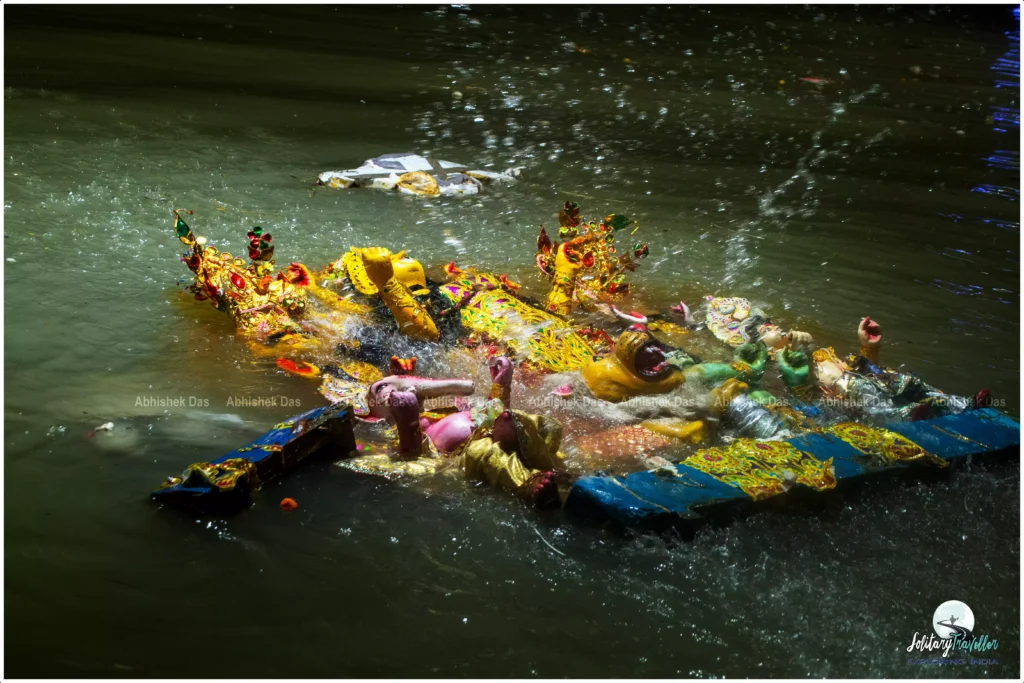
At the Babughat, the atmosphere is electric with sorrow and devotion. The same river, the Ganga, whose clay gave the idol its soul, is now ready to welcome her back.
As the crane lowers Maa Durga into the dark, flowing waters, a collective hush falls. The clay dissolves. The straw floats away. The glitter washes off. The magnificent form we adored for five days merges back into the elements.
This is the ultimate philosophy of Pujo. It’s our annual lesson in impermanence. We build something so beautiful, we celebrate it with every fibre of our being, and then we let it go. We watch it dissolve before our eyes. It teaches us detachment, the cyclical nature of life, and the beauty of a graceful goodbye.
Standing there, watching the marigolds and flickering lamps float away, my heart is heavy, yet full. There are tears, but there is also a profound peace. It’s not a permanent goodbye. It’s a “Bolo Durga Mai ki Jai!” until next year.
Pro-Tips from a Probashi (Local):
- Transport: The Kolkata Metro is your best friend. It’s fast, cheap, and avoids the impossible traffic. Get a smart card.
- Footwear: Wear your most comfortable, closed-toe shoes. You will walk more than you ever have. Trust me.
- Beat the Crowds: For the top 10 pandals, go either very early (6-8 AM) or very late (after 1 AM). The prime-time queues are for the brave and patient.
- Safety: While Kolkata is generally safe, keep your wallet and phone secure in crowded places.
- Etiquette: Dress modestly inside pandals. Be respectful during rituals. Ask before taking close-up photos of people, especially during emotional moments.
My Personal Favourites (Try These!):
- For Heritage: Shobhabazar Rajbari, Rani Rashmoni’s House.
- For Spectacle: Santoshpur Club, Sree Bhumi Sporting Club.
- For Food: Bhawanipore Pujo (for bhog), Mudiali (for street food).
- For a Quiet Moment: Any small, unassuming puja in a North Kolkata alley. That’s where the soul is.

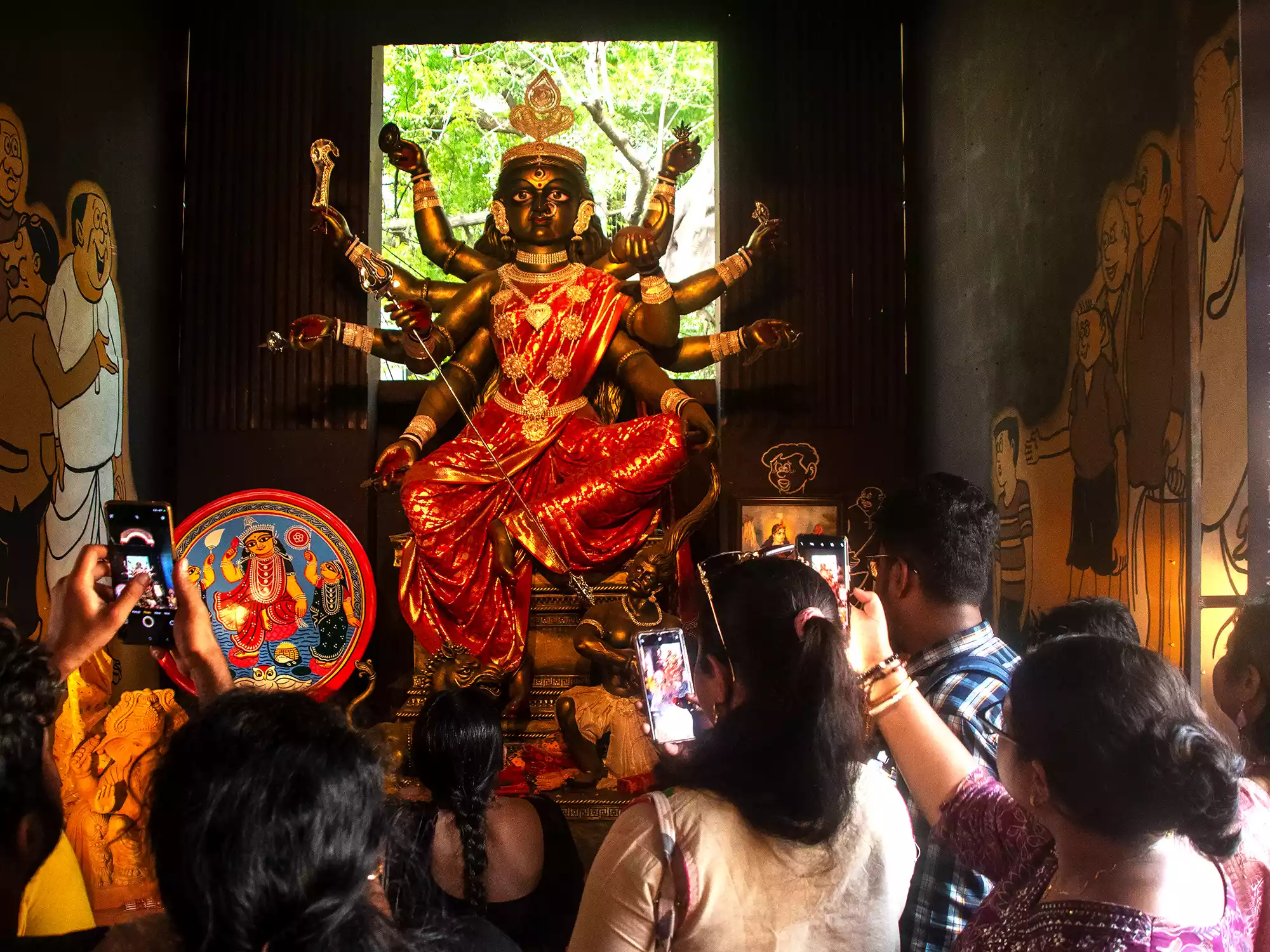
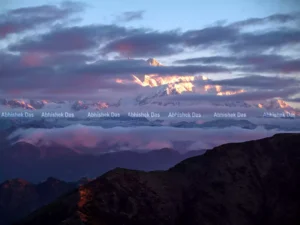

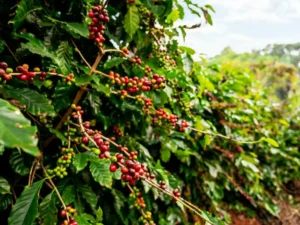
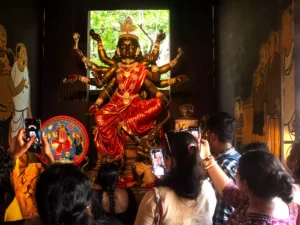

Comment (0)